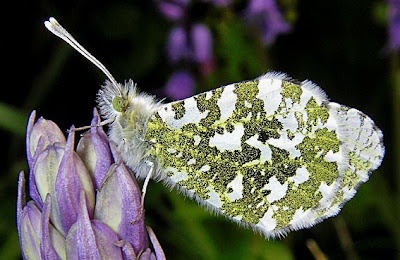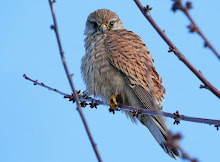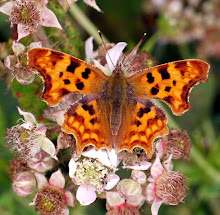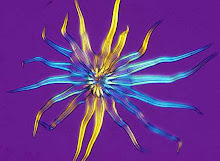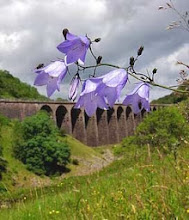Thursday, May 31, 2012
Wildlife on Walls: 5. Wall Rue
There aren't many plants that are so intimately associated with man-made walls that this tough little fern, wall rue Asplenium ruta-muraria.
It's likely that human constructions in brick and stone have extended its range because it's a species that prefers an alkaline substrate - and the mortar between bricks and rocks provides and excellent substitute for limestone in areas with a more acidic natural geology. Stretching the point a little, you could argue that the Romans helped widen the distribution of this fern because they introduced mortar as a means of constructing walls. Without this inadvertent human assistance, this would be a much rarer fern.
It produces spores under those leathery, drought-resistant fronds which have a distinct coincidental similarity to rue Ruta graveolens.
Labels:
Asplenium ruta-muraria,
Dry stone Walls,
wall rue,
walls
Wednesday, May 30, 2012
Wildlife on Walls: 4. Garden Snail, Helix aspersa
The recent hot, dry spell has triggered some distinctive behaviour in snails that helps these moisture-loving molluscs survive long, dry periods.
It's called aestivation and involves the animal secreting a thick layer of mucus that cements the mouth of the shell to a hard substrate, minimising water loss.
The shady side of an old stone wall with plenty of gaps between the rocks is the perfect place to aestivate through a drought and numerous snails often pack themselves into these crevices, until the classic British wet summer returns. Like many invertebrates, the internal organs of dormant snails shrink substantially once they've sealed themselves in their shell and stop feeding.
It's called aestivation and involves the animal secreting a thick layer of mucus that cements the mouth of the shell to a hard substrate, minimising water loss.
The shady side of an old stone wall with plenty of gaps between the rocks is the perfect place to aestivate through a drought and numerous snails often pack themselves into these crevices, until the classic British wet summer returns. Like many invertebrates, the internal organs of dormant snails shrink substantially once they've sealed themselves in their shell and stop feeding.
Labels:
aestivation,
Garden snail,
Helix aspersa,
molluscs,
walls
Tuesday, May 29, 2012
Built for speed
I spent a long, hot afternoon trying to get a decent photograph of a swallow in flight - with no success. Finally this one landed to preen its feathers, looking beautifully streamlined. They look fast even when they are at rest, don't they?
Labels:
swallows
Sunday, May 27, 2012
Unusual Fly-past and the Wobbly World of Heat-haze
This black swan from the collection of ornamental waterfowl on the boating lake at Cleethorpes joined the local mute swans for a fly-past this morning, while ....
.... out beyond the saltmarsh a little egret, a classic sailing ship and the wind turbines on the Yorkshire coast of the River Humber all had some wind in their sails, even if everything was shimmering in a heat-haze
Labels:
Black swan,
Cleethorpes,
Little egret,
Mute swan,
River Humber
Friday, May 25, 2012
Hot Bird
Every afternoon this week this blackbird has been sunning itself in the hottest spot in the garden, in our potato patch. It sits in a trance, wings spread out, panting with its beak open, eyes glazed over .... and potentially easy prey for cats. Given the risk, there must be some biological imperative for this behaviour. The favourite theory seems to be that the heat forces parasites in the feathers on its back to move around, making it easier for the bird to reach them with its beak.
Wednesday, May 23, 2012
Wildlife on Walls: 3. Viviparous Lizard
If you are a viviparous lizard (aka common lizard, aka Lacerta vivipara), on the lookout for food, safe shelter and warmth, then a dry stone wall has a lot to recommend it.
The sunny side of the wall is the perfect spot to bask in the morning after a cold night, until your blood warms up....
... and those nooks and crannies between the stones are a safe retreat when dangers - like moorland kestrels, for example - hove into view. Add to that the fact that the wall is probably home to plenty of small, tasty invertebrates that you can snack on, plus the way in which the sun-warmed stones tend to act as a night storage radiator after darkness falls, and its easy to see why dry stone walls are amongst the best places to look out for these lovely reptiles.
I took these photos (which are scanned colour transparencies) a few years ago now, on a dry stone wall on the moors above Wolsingham in Weardale. Must go back soon for another look ......
More on the wildlife of walls here.
More on local reptiles here.
Tuesday, May 22, 2012
Wildlife on Walls: 2. Cladonia macilenta
In the beginning, when the glaciers melted, there was nothing but bare rock. And lichens thrived there. Then came the grasses and flowers in newly weathered soils, followed by scrub and finally forest whose shade cast out the bare rock-loving lichens. Then came humans with their axes and fire, cutting and burning the forest to grow crops and graze animals that often wandered away. So their owners quarried rocks and built walls. And then the lichens - like this Cladonia macilenta (I think - correct me if I'm wrong) found a new habitat on the rocks that humans piled one on top of another, in an unconscious act of habitat creation. Full circle.
Under close scrutiny, lichens are extraordinarily beautiful organisms - an intimate amalgam of alga and fungus, with each different combination producing a lichen of a distinct shape, colour and texture. The granular columns here, rising from those grey-green scales,are called podetia. They're tipped with red apothecia that produce fungal spores that will blow away, land on a rock, germinate and - if they happen to have landed close enough to a compatible alga, form a new lichen, just as they did on bare, broken rock left by the glaciers.
More on walls and their associated wildlife here
More lichens here
Labels:
Cladonia macilenta,
Dry stone Walls,
Lichens,
walls
Monday, May 21, 2012
Strange Bee-haviour
I found this little cuckoo bee (Nomada sp. - possibly N. succinta, but there are scores of rather similar species to choose from!) clinging on in his strange way to a developing Amelanchier fruit in the garden this afternoon, apparently feeding on something that looks like it might be a fungal mould. It has beautiful eyes but rather less attractive habits, since it's a kleptoparasite of the nests of other solitary bees.
Africa Gomez over at BugBlog has just posted some very fine photos of its victims and Annie Gates, a gifted young wildlife photographer, has another photo of a cuckoo bee, much better than mine, over on her father's blog at The Living Isle.
Africa Gomez over at BugBlog has just posted some very fine photos of its victims and Annie Gates, a gifted young wildlife photographer, has another photo of a cuckoo bee, much better than mine, over on her father's blog at The Living Isle.
Labels:
cuckoo bee,
Nomada
Sunday, May 20, 2012
Wildlife on Walls: 1. Yellow Corydalis, Pseudofumaria lutea
Wildlife has a wonderful ability to colonise man-made structures that mimic natural habitats.To many organisms walls are nothing more than exposed rock faces or low, inland cliffs. These are relatively rare natural habitats in much of the British Isles but their artificial equivalents - stones walls - are everywhere, in towns and the countryside sometimes stretching for miles across the landscape and built from a wide variety of rock types, sometimes held together with mortar, sometimes merely piled one on top of another.
Natural cliffs are a habitat colonised by specialists - plants and animal that can thrive where there's little soil, often extreme changes in temperature, shortage of water and extremes of sunlight and shade. So cliffs' artificial equivalents are similarly colonised by some interesting, highly adapted organisms. This wall, for example, around Romaldkirk church in Teesdale, has been colonised by a wall specialist - yellow corydalis - which has an interesting method of sowing its seeds.
Yellow corydalis Pseudofumaria lutea comes from the lower slopes of the southern Alps in Italy and Switzerland and has grown in Britain since at least 1596. Two hundred years later it was first recorded in the wild and since then it has spread throughout almost all of southern and central England, most of Wales and parts of Eastern Scotland, Northern Ireland and to a few locations in Ireland. It's still extending its range. You can view a distribution map here.
It's uncommon to find it growing anywhere other than on walls, where it thrives - and that's probably because its seeds are equipped with a structure called an elaiosome - a protein and lipid-filled extension which is irresistible to ants - so they take the seeds with their food source back to their nests, and in so doing lodge the seeds (which they don't eat) in cool, damp crevices deep within walls. For those who like botanical jargon, there's a name for this ant-aided seed sowing - myrmechocory.
For more on dry stone walls, click here.
Labels:
Pseudofumaria lutea,
Romaldkirk,
Teesdale,
walls,
yellow corydalis
Saturday, May 19, 2012
The Ultimate Mega-Tick for a Birder?
Last week, when we were walking along the cliff tops south of Seaham, all the blackthorn and hawthorn bushes were alive with the songs of whitethroats. Coincidentally, on the same day I happened to read a recently published scientific paper in the journal Ticks and Tick-borne Diseases , authored by scientists at Health Protection Agency at Porton Down, at the Portland Bird Observatory and at the Food and Environment Research Agency that cast light on a less welcome aspect of the arrival of these annual summer migrants. They found that whitethroats and wheatears were often infested with the tick Hyalomma marginatum that transmits Crimean-Congo haemorrhagic fever, which has occured with increasing frequency in Eurasia and kills up to 30% of its human victims. You can read gruesome details of this disease here.
I remember, years ago, rescuing a swift that had become trapped in a house loft and watching with fascination as a tick crawled out from behind its eye, bit me on the thumb then crawled back amongst the feathers. In the light of this scientific paper, I'd think twice about handling any bird without gloves.
Labels:
parasites,
Silvia communis,
Whitethroat
Wednesday, May 16, 2012
The Cats' Pee Orchid's Life of Deceit
We found a fine display of early purple orchids blooming on the cliff tops south of Seaham, along the Durham coast, today. They're beautiful flowers to look at but less attractive when you smell them, as they emit a strong aroma of cat's urine which is generally repugnant to people but attractive to bees........ which are in for a disappointment when they visit these flowers.
Charles Darwin spent many years studying orchids and was intrigued by their elaborate flowers and complicated pollination arrangements. In his seminal book in the subject, The Various Contrivances by which Orchids are Fertilised by Insects, first published in 1862 and which you can download here, he noted that although the flowers have a well developed nectar spur they don't produce any nectar. Bees that visit are duped into exploring one or two flowers in an inflorescence but soon leave when they find no sweet reward - but by then they've performed the essential pollination service that the plant requires.
This is Darwin's detailed dissection of an early purple orchid flower. The two important features to note are the hollow nectar spur in the uppermost illustration, which shows a longitudinal section of the flower, and the club-shaped structure in the centre, which is the pollinium containing the pollen grains.
Try as he might, Darwin could find no trace of nectar in the nectar spur and was reduced to suggesting that if visiting bees did extract any reward from the flower it could only have been by piercing the floral tissues with their proboscis, which has never been proved to be the case. He concluded that the basis of pollinator visits was deceit on the part of the plant, that relied on naive, newly-emerged bees in spring making exploratory visits to any flower that might contain a food source.
The other part of the flower that intrigued Darwin was the pollinium - the male stamen that is carried away in its entirety when a bee probes for nectar and the pollinium sticks to its tongue (click here for a picture of a pollinium-encumbered bee visiting an orchid).
Each flower has a pair of pollinia - they're the two dark, club-shaped structures under the hooded petal in the flower above. When they're carried away by a bee they bend forward within about a minute, so they're well positioned to make contact with the stigma of the next orchid flower it visits.
In his book Darwin demonstrated rather neatly how you could mimic the whole process by poking a sharpened pencil into the flower. Try this - it really works. When you withdraw the pencil with the pollinia attached their stalks dry out and they slowly bend forwards. Incidentally, the ever-meticulous Darwin dissected, counted and estimated the number of pollen grains in a single pollinium - a staggering 122,400.
This orchid's deceitful pollination technique is only partially successful because bees are smart and after visiting a couple of flowers look elsewhere for an energy reward. Darwin's work was followed up in the 1990s by Dr. L.A. Nilsson at the University of Uppsala who showed that bees would visit more flowers on an inflorescence if those empty nectar spurs we filled with artificial nectar.
Nilsson noted that early purple orchids only produce a few seed pods, developing from the first few flowers to open at the bottom of the inflorescence. The rest almost always remain unfertilised, although 80% of them could set seed if they were hand-pollinated. The first bees of spring may be naive but they learn fast and if they don't find the reward they are looking for they soon ignore that attractive scent of cats' pee and take their pollination services elsewhere, leaving many early purple orchid flowers unpollinated.
Fortunately the seed production from a single pollinated flower is quite large ..........Darwin counted 6200 seeds in a single capsule of spotted orchid and this species' seed production would be similar.... so early purple orchids manage to survive on deceit.
Tuesday, May 15, 2012
Dry stone Walls
Dry stone walls are the most conspicuous, ubiquitous man-made structures in the north Pennines. There are thousands of miles of them and they've been used to enclose land for centuries, especially in areas where sheep are farmed. Building them is a highy skilled craft that was delightfully described in a booklet by Arthur Raistrick called The Story of the Pennine Walls, published by Dalesman Publishing back in 1946 (see below).
Raistrick described a dry stone wall as being ".. a structure in a state of equilibrium", thanks to a method of construction that ensures that all the internal forces bear down through the wall faces that are assembled in a way that prevents the wall bulging outwards. The stretch of wall in this photograph, alongside the old railway line that ran from Tow Law to Consett in Co. Durham, is eight feet tall in places and as straight and robust as the day it was built.
This photograph of a wall in Teesdale shows some of the key features. After digging out the footings to a width of about four feet the wall was built on a foundation of large stones and is actually a double wall with infilling. In the best walls the infilling of small broken stone isn't simply tipped in; the stones are wedged in individually, to support the outer wall layers which are built with overlapping stones, of decreasing size from the ground upwards, on either side. In a typical wall there are two courses of 'throughs' near the middle and near the top. These thinner flat stones run right through the wall, often protruding on either side, and help to tie the two faces of the wall together. The top layer of throughs also provides the base from the capstones.
Walls built in this way stretch far across the landscape, snaking around boundaries and following the rise and fall of the land. As Raistrick said, "The extent of walling in the Pennines represents many lifetimes of patient skill spent in hard manual work. We benefit today by the work of these generations and it is incumbent upon us to maintain the walls in good repair". Fortunately, there still seem to be enough skilled craftsmen around to do just that in many parts of the dales. They have their own professional Dry Stone Walling Association, with an excellent web site here.
In addition to gateways, many walls incorporate these 'cripple holes', just big enough for sheep and a sheep dog to squeeze through, so that sheep could be easily moved between pastures and separated, before the hole was stopped up with a flat slab
These hundreds of miles of stone walls are a wildlife habitat in their own right, representing as they do a vast expanse of inland cliff faces, with shaded or sunlit aspects, that plants can root in and animals can shelter in ......... but that, as they say, is another story..............
Arthur Raistrick's booklet on dry stone walls carried this very fine cover design by Edward Jeffrey. Well worth looking out for a copy if you can find one in a second hand bookshop. Jeffrey was the illustrator of the Toby Twirl children's adventure stories, which I remember vividly from my childhood.
Thursday, May 10, 2012
Where the Bodies are Buried ...
Today's Guardian Country Diary describes a field excursion with some Durham University biology students to Chapel Fell, between Weardale and Teesdale in Co. Durham
We were lucky from the weather and the views were stunning, although there were still patches of snow on the ground so it was pretty bracing up there. This is just about the last place in the local landscape to show signs of spring but if you take your eyes off the view and look at the ground under your feet there are plenty of signs of growth in the upland mosses. Some beautiful lichens thrive here too.
Bogs like this are deep pools filled with Sphagnum moss and are a potential death trap. Stroll onto this fine green 'lawn' and you'd instantly disappear up to your neck (at least) in ice-cold water.
Sphagnum moss is a living sponge that retains vast amounts of water, thanks to its unique leaf structure which you can see by clicking here. Once you get about a metre down from the surface it's pretty anaerobic and preserves biological materials (like drowned bodies) extremely well. You can read about some fine examples of corpses exhumed from peat bogs by clicking here.
In more open patches of water the moss takes on this very attractive starry appearance.
Sphagnum species identification is a specialist skill (there are around 36 species listed in the latest field guide) that I've never mastered and there are several species up here that would keep dedicated bryologists occupied for some time, including ...
.... this delightful claret-coloured example.
One day I'll learn to identify them, using his excellent key.
Polytrichum species thrive on the drier banks ....
.... and this one, which I think is Hylocomium splendens, has intensely red stems bearing yellowish leaves and does well amongst the heather stems that have yet to show much sign of new growth.
This is also home to some fine lichens (mostly Cladonia species) .....
I think this may be Cladonia diversa
Labels:
Chapel Fell,
Cladonia,
Guardian Country Diary,
Lichens,
mosses,
peat bogs,
Polytrichum,
Sphagnum,
Teesdale,
Weardale
Tuesday, May 8, 2012
"Go back! Go back!"
People up here in the North East are famed for their warm welcome for visitors but red grouse could do with a bit of hospitality training - the parting shot in their alarm call when anyone encroaches on their territory sounds very much like 'go-back, go-back'
Mind you, since they're going to be shot at in a few months time I guess it's understandable....
There's another fine sound recording made in Allenheads, not far from where this rather more friendly female was photographed, here
This recording was made by Richard Dunn whose work is here on the wonderful Xeno-Canto web site.
Labels:
grouse,
grouse moors,
red grouse
Sunday, May 6, 2012
Assassins on the Pond Surface
Even though there was a frost last night and the pond surface briefly froze, there were two pond skaters Gerris lacustris out hunting by mid-morning, on the lookout for any small insects that had become trapped in the surface film .....
..... like this one. At this time of year most of the prey items are small but in summer I've sometimes seen pond skaters descending like a pack of wolves on drowning wasps.
This one, with a nightmarish countenance, has caught a small fly whose wing you can see held between the short front legs of the predator.
The pond is currently suffering from an algal bloom which slows down the skaters' progress across the surface and sometimes clogs the microscopic hairs that makes these hunters water-repellent. They are spending a lot of time grooming the algae off their body surface and when they do this, grooming the second leg against the third leg on each side in turn, they use one of those short prey-capture legs at the front as the third leg of a tripod to support themselves - normally, when the animal is on the move, the front legs are held just above the water surface. The greenish-yellow deposit on that middle leg on the left-hand side in the picture is a patch of algal cells that the insect hasn't managed to remove yet.
At the moment there are only two pond skaters present and the larger one, top left, is the female. They seem to be courting, by slowly approaching and extending a middle leg towards each other. They breed in May so she'll be laying eggs now and by the end of the month I'm expecting to see nymphs scooting across the surface.
Labels:
Gerris lacustris,
Pond skaters
Saturday, May 5, 2012
What happens when a raindrop, travelling at terminal velocity, hits a butterfly .....?
I've never seen an insect actually hit by a raindrop but I did once read an eyewitness account (of dubious reliability) of such a collision with a bumblebee in flight, which supposedly killed the bee. It came to mind yesterday as a dark rain cloud slid over the sun while I was photographing this newly-minted female orange tip butterfly visiting bluebells.
Almost immediately the butterfly folded its wings as completely as possible, assumed a vertical position on a bluebell infloresence and even aligned its antennae tightly in line with its body axis - all of which presented the smallest possible target for a falling raindrop. I wonder if this instinctive behaviour is triggered by the sudden drop in light level and temperature that's characteristic of an approaching shower on a spring day? Many insects crawl away under leaves during rain showers but orange tips always seem to roost in the open. I've often found dew-covered specimens early in the morning.
As soon as the sudden and very heavy shower had passed I went out to take a look and found the butterfly unharmed..... hard to believe that it hadn't been knocked off its perch by the downpour!
Labels:
orange tip butterfly,
Rain
Subscribe to:
Posts (Atom)


















































